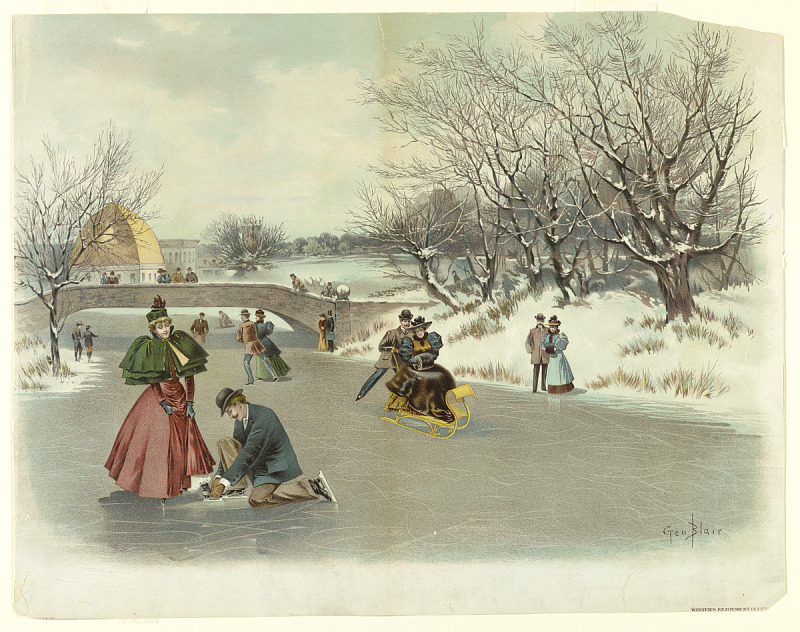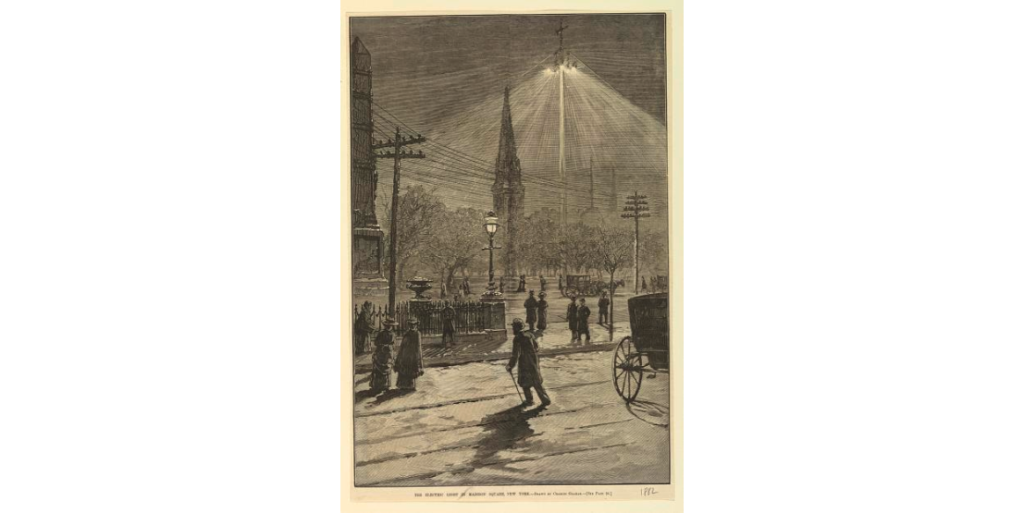The Cold Snap of January 10th
By William Hoyt Coleman
Annotations by Maggie Kelly

Bitter, bitter cold! Nine degrees below zero, says the thermometer in the city. Away to the northward, it creeps down to thirty and forty. The snow creaks under foot, and rings with a musical sound, as the heavy wheels roll over it, for Jack Frost can make music as well as paint pictures. What wonderful scenes grow under his busy hand on window-panes in hall and hovel! Trees, and flowers, and castle, and mountains, and fairies, glittering on the wrinkled panes of the Five Points, and on the plate-glass of Fifty Avenue. [1] But few people care to look at them. Glowing fires are pleasanter pictures to those in-doors. And who can stop in the biting air, outside, to look at anything?
People trot along the walks, slapping their sides, blowing their fingers, and now and then slipping up, and coming down with a heavy thump on some bit of ice.
Youthful beards are venerably gray; whiskers of every hue are edged with white, and even the horses have a fringe of icicles around their noses. Slim clerks and portly merchants, muffled in overcoats, shawls, furs, and comforters, rush hastily down-town-ward, puffing clouds of frosty breath like so many locomotives. The rivers are smoking too. Down in the bay a white mist is rising from the water. One would think old Neptune was getting up a good vapor-bath, or that some waggish imp were really “setting the river on fire.” [2] The poor omnibus drivers! Well may they dread this weather. Tough as they are, the nipping air touches them cruelly during their long, bleak drives. We do not wonder when the morning journal tells us that one poor fellow was taken senseless from his box.

The sun shines bright, but there is no heat in his rays. One can look him in the face at noonday without harm; he is shorn of his strength. In-doors, furnaces, grates, and stoves are choked with coal, till the red-hot iron glares in fury. Jack Frost and the Fire King are in fierce contest. Folks shiver and shake, and confess Jack the victor.
So the day wears on. Night comes with increasing cold. Frozen noses, hands, and toes are to be met with in all parts of the city. People hie them home with all speed, and none walk that can ride. “The cold has got into the house,” says mother; and father believes it. Water-pipes are on a “bust,” and the meter won’t mete, unless it has plenty of whisky. [3] Extra cups of tea are taken at supper; and not a few warm their stomachs with something stronger. The spare blankets are brought out, the beds are loaded, and the household retire at an early hour, to curl themselves up into little balls, and shiver through the night; getting “warm as toast” just as the bell rings the next morning.
But how fare the poor to-night? In dwellings cold and cheerless, with scanty fires and scantier beds, or destitute of both, let imagination picture how. Let her picture those homeless ones, wandering through the streets, sleeping in coal-boxes, or on the bare ground—to awake in another world. I will not do it. And so New York passed through the Cold Snap, snapping its cold fingers at old Boreas, [4] as if he had no right in the city.
Coleman, William Hoyt. “The Cold Snap of January 10th.” Robert Merry’s Museum, March 1859.
[1] Five Points was the name of a 19th-century neighborhood in New York City.
[2] Neptune: the Roman god of the sea and freshwater; Waggish imp: a mischievous sprite
[3] In this sentence, the speaker is making a joke about the water pipers, which have frozen and burst, and the gas or electricity meter, which won’t record consumption unless it’s had an alcoholic beverage to warm it up.
[4] Boreas is the Greek god of winter and the North wind.
Contexts
This piece appeared in March 1859 edition of Robert Merry’s Museum, a popular children’s magazine at the time. The author of this short piece is William Hoyt Coleman; he “was one of the most popular and prolific subscribers to Robert Merry’s Museum; in letters spanning 13 years, he often wrote descriptions of life and times in New York state. He later became a journalist” (Pflieger). Coleman was 19 or 20 when this piece was published. If you’d like to learn more about Coleman, be sure to check out Pflieger’s bio of the author.
Resources for Further Study
- For more information about Robert Merry’s Museum, be sure to check out Pat Pflieger’s extensive website on 19th century children’s literature; this website features a page dedicated to this magazine in particular, which not only has selections from the magazine, but historical information and scholarly resources as well.